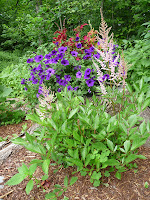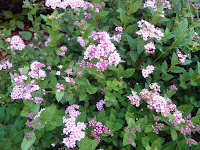It was beautiful, clear skied weather this past weekend but unseasonably HOT. Working outside with temperatures hoovering in the high 80's presents some challenges for someone acclimatized to Northern spring weather such as myself but am still tickled to have had the whole weekend outside as I continue to weed, edge and mulch the landscape beds as well as get the veggie garden well under way.
Keeping a steady, albeit slower, working pace and taking frequent breaks to rehydrate simply presented more opportunities to walk around and see what's up.
 |
| Vaccinium corymbosum L. |
I would imagine that most people viewing this photo would see a lovely shrub bearing clusters of white, bell shaped flowers.
I see my favorite fruit of all time, blueberries. To think that each one of those little white flowers will turn into big plump dark blueberries just makes my mouth water thinking about it.
I have 4 highbush blueberry shrubs that I planted 7 years ago that now stand about 4' tall and have been producing very well for the past few years (providing I get the net over them before the birds clean me out).
And the beauty of this shrub doesn't end there with fall foliage colors in various shades of burnt red.
But plant them for the fruit...
I've always been attracted to plants whose flowers sit on stems rising above it's foliage and this plant was no exception. So the first time I saw it in bloom, I wasn't disappointed.
 |
| Polygonum bistorta 'Superbum' |
The 16" stems are rigid requiring no support and the pale pink 'poker' flower displays well into June and again later in the season, but it's the spring showing that's the most dramatic.
This hearty, neat and easy to grow plant sounds like a dream until you forget to manually keep it at bay. A vigorous grower, it will take over your garden if you let it. Luckily it's easy enough to pull out when it starts to get out of control. It's also a bit unclear as to the correct name since it also goes by Persicaria bistorta 'Superba'.
Oh well, it's not the first plant whose botanical name has been changed by the powers that be. I think it's really all just a test to see if we've been listening. :)
I also got around to potting up all my hanging pots, flower boxes, barrels.... whatever I can stick some annuals into and finally found a good use for this old large enamel pot that I had kicking around.
So I got out my new 18 volt cordless drill and popped 4 holes in the bottom (no small feat I might add) for drainage and filled it with planting mix, a few coleus and petunias and sat it on the stump of the old ash tree I had removed 2 winters ago.
It's a big pot but it looks so small sitting on the old stump. Hopefully once the planter fills in and out a bit it will blend in better. Or maybe not. Only time will tell.
Meanwhile, the rosy lights azalea on the east side of the house made quite a showing this weekend in full bloom.
There are literally thousands of varieties of the genus
Rhododendron and recent significant breeding towards even more super hardy azaleas and rhododendron going on in Finland.
In the meantime, the Northern Lights series developed by the University of Michigan and released in 1978 still stands as the standard for our USDA zone 4.
The azalea loves sun and while I have other azaleas located in a more sun protected bed on the north side of the house, they still bloom - just a bit later than this.
I spent alot of time cleaning and prepping the raised beds in my vegetable garden before they were ready to plant. I do have leafy greens that have already sprouted and this weekend planted tomatoes. I planted
Jet Star tomato (a generally reliable, disease resistant hybrid) but am excited to have added heirloom
Pruden's Purple Tomato (not really purple but a deep red) which rivals Brandywine,
Black Cherry Tomato which produces clusters of dark, rich flavored 'snack' tomatoes,
Black Krim ( an indeterminate, dark red to brown cultivar) and
Red Pear Piriform (a juicy, sweet flavored Italian heirloom with green, ribbed shoulders).
 |
| the vegetable garden |
And that's just the tomatoes!
While I was finishing up for the afternoon I noticed the house wren that had moved into the newest birdhouse on the corner post popping in and out of the house with little bits of white fluff that she simply did not find appropriate as nesting material for her eggs. She must've gone in and out a dozen times, each time spitting out another bit of 'whatever'.
It occurred to me that often in life couples do not share the same decorating sense but that often times it is one who makes the final decision. :)

 The blooms arrive in late July and August with multiple floretes that open progressively along 3" to 5" racemes.
The blooms arrive in late July and August with multiple floretes that open progressively along 3" to 5" racemes.
 Another really showy plant in bloom right now is this perennial Hibiscus 'Kopper King'. Beautiful coppery - red disected leaves, this plant stands tall at 3 to 4 feet.
Another really showy plant in bloom right now is this perennial Hibiscus 'Kopper King'. Beautiful coppery - red disected leaves, this plant stands tall at 3 to 4 feet.
















































